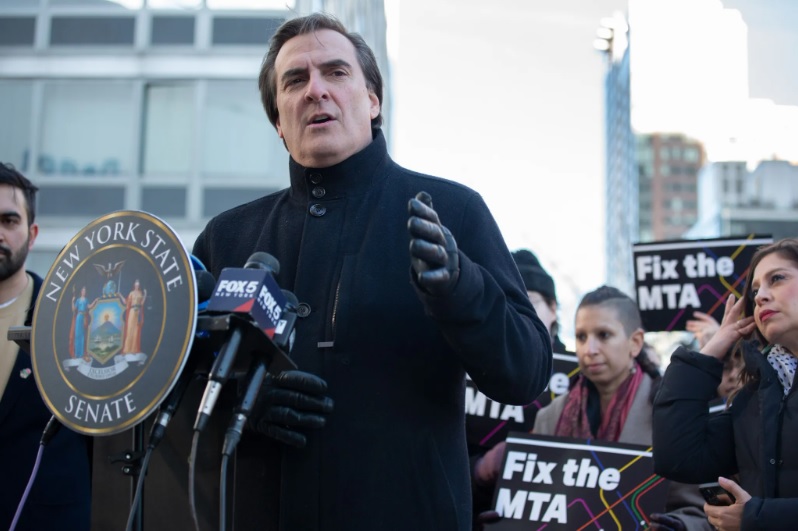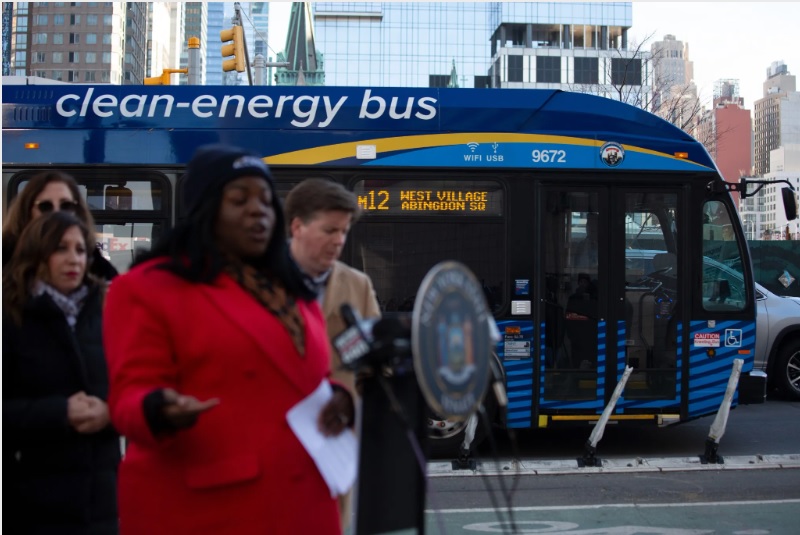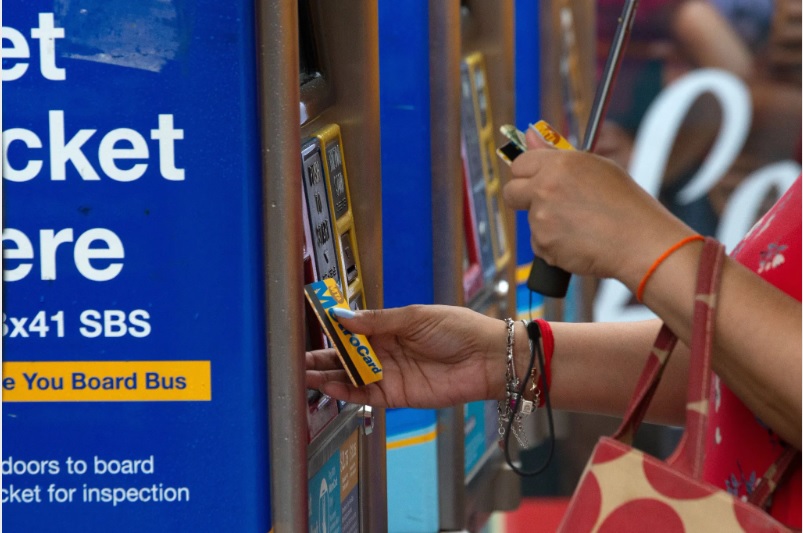
Riders take a B54 bus toward Jay Street in Downtown Brooklyn, Dec. 7, 2022.Ben Fractenberg/THE CITY. The proposals would freeze the current $2.75 price of subway and bus trips and would roll out free fares by borough over four years.

This article was originally published by The CITY on Dec. 14
As the country’s largest mass transit system teeters on the edge of a so-called fiscal cliff, New York lawmakers on Wednesday touted a package of “Fix the MTA” bills designed to pull the agency back from the brink of financial free fall.
The proposals from state Senate Deputy Majority Leader Michael Gianaris and Assemblymember Zohran Mamdani, both Democrats representing northwest Queens, would freeze the price of subway and bus trips — and even allow New Yorkers to board buses for free for four years.
Just last month, the MTA warned that riders may face higher-than-projected fare hikes, with the cost of a bus or subway ride going as high as $3.05 by 2025.
The call for no-pay rides comes days after THE CITY reported that some MTA board members have thrown their support behind the idea after it got the green light in Boston and Washington, D.C. — but which would require city, state or federal lawmakers to come up with significant new funding sources.
Fully phased in, the fare-free bus program would cost $678 million per year.
Without more money, Gianaris said, the transit system could be on an express track toward financial calamity.
“The support from me and my colleagues in the Senate is there,” said Gianaris, in announcing the legislative agenda. “We’re going to roll up our sleeves during this next budget process and do more than just make sure that trains aren’t falling apart.
“Let’s make sure the train system is the envy of the world.”

State Sen. Michael Gianaris speaks outside a Manhattan bus depot about funding free bus service in the city, Dec. 14, 2022.Ben Fractenberg/THE CITY
Standing outside the Michael J. Quill Bus Depot on Manhattan’s West Side, Mamdani, Gianaris and other elected officials touted a series of ideas for new funding streams that they say could fill a budget deficit that the MTA expects to climb to $2.5 billion once it burns through $15 billion in federal emergency aid.
“We are not simply going to fill that deficit,” said Mamdani, a second-year lawmaker who has been working on the proposal since early this year. “We are going to fix the MTA.”
Necessary to NYC
Janno Lieber, MTA chairperson and CEO, has for months called on lawmakers to find new sources of revenue for a transit system that he has repeatedly likened to “air and water” for New Yorkers and which he has said should be funded similarly to essential services such as police, fire and sanitation departments.
Pre-pandemic, the MTA counted on farebox revenue to fund 51% of its operating budget — a higher proportion than many other U.S. transit systems, including the Massachusetts Bay Transportation Authority (45%), the Chicago Transit Authority (41%), the Southeastern Pennsylvania Transportation Authority (35%), the Washington Metro (33%) and the Los Angeles Metro (15%).
But the MTA has said a post-pandemic revenue ratio of 35% from fares is likely because of ridership numbers that remain well below 2019 levels, as many New Yorkers no longer commute to their offices as frequently.

A M12 bus heads down 11th Avenue past a press conference about making bus fares free, Dec. 14, 2022.Ben Fractenberg/THE CITY
“Albany recognizes it, Washington recognizes it, the MTA recognizes it,” John Samuelsen, international president of the Transport Workers Union and an MTA board member, told THE CITY. “They can’t keep doing what they’ve always done, so they need to change their ways.”
Transit experts note, however, that free rides should not come at the cost of reliable service.
“You have to make sure it’s at a level that doesn’t result in worse service,” said Robert Puentes, president and CEO of the Eno Center for Transportation, a Washington think tank.
The lawmakers said they envisioned the fare-free bus program first rolling out in The Bronx, where the MTA says more than half of all riders do not pay to board buses. It would go to Brooklyn the next year, followed by Queens and Manhattan, then Staten Island.
The MTA suspended fare collection on local bus routes in March 2020 to reduce drivers’ exposure to COVID-19. Collection resumed in August of that year, though fare evasion has remained especially high on Bronx and Staten Island buses.
“We also saw that the moment fares were reinstituted here in New York City, ridership dropped 23% immediately,” said Assemblymember Amanda Septimo (D-The Bronx). “That shows you that people aren’t going to continue to pay for service that isn’t up to par.”
‘Got to Make It Up Somehow’
An MTA spokesperson cited a recommendation from Gov. Kathy Hochul and Mayor Eric Adams in the “New New York” economic development report published Wednesday that the agency needs a sustainable operating budget.
The panel also recommended that the “City Ticket” program, which allows for $5 trips on the MTA’s commuter railroads within the city, be made available 24/7. It is currently available only during off-peak hours.
“We look forward to working with all our partners in Albany, City Hall, and Washington over the next few months to identify new recurring revenues so we can deliver the essential mass transit services that are the economic and equity engine of the region,” said MTA spokesperson John McCarthy.
CEO Lieber, while calling for new funding, has previously voiced skepticism about fare-free bus service.

MTA ridership levels have remained far below pre-pandemic figures.Ben Fractenberg/THE CITY
“We can all imagine that the proverbial pigs are going to fly, hypotheticals that are not going to happen,” Lieber said in February. “Nobody’s offering me a billion dollars for something other than closing the MTA’s $2 billion-plus fiscal cliff.”
The proposals from the state lawmakers on Wednesday come with a big question: How can an agency already facing what officials have described as an “existential crisis” fund improvements without sacrificing service frequency or safety?
It’s estimated that the MTA would need an extra $3.26 billion from somewhere to fund the entire package.
“You’ve got to make it up somehow,” Danny Pearlstein, policy director of Riders Alliance, told THE CITY. “Also, transit fares have become much more of an equity issue in New York since the pandemic, because of who can work at home and who can’t.”
JP Patafio, a TWU Local 100 official who has been pushing for fare-free transit for two years, called the idea for fare-free bus trips one that is worth trying as New York emerges from nearly three years of a pandemic.
“This is a social issue, it’s obvious,” Patafio told THE CITY. “We saw during the pandemic that buses are an essential service and how they kept the city moving.”
THE CITY is an independent, nonprofit news outlet dedicated to hard-hitting reporting that serves the people of New York.
One Comment

In ancient Rome, government attempted to curry favor with the masses by offering free bread and circuses. Now we have a call for free NYC Transit bus rides. Will this apply to $6.75 express buses as well? The MTA currently faces a multi billion dollar multi year financial deficit. This does not include future wage increases that the Transit Workers Union (TWU) will ask for when their current contract expires in May 2023. The MTA only budgeted 2% per year for the next contract. The TWU will obviously ask for far more just to keep up with inflation.
The Metro Card introduced in 1996 affords a free transfer between bus and subway. Prior to this, riders had to pay two full fares. A majority of residents purchase either a weekly or monthly NYC Transit bus/subway Metro or OMNY Card. NYC offers a “Fair Fares” program to help New Yorkers with low incomes manage transportation costs. Using the Fair Fares NYC MetroCard, eligible NYC residents receive a 50% discount on subway and bus fares. .
Financial viability of the MTA has always been a four way dance between farebox revenue, City Hall, Albany and Washington. All we ask in return is a reliable, safe, on time trip and as periodically necessary – a reasonable fare increase that doesn’t exceed the current inflation rate. There also needs to be real legal consequences to those who don’t pay their way and contribute to fare evasion which will reach $500 million in 2022. There is no such thing as a free lunch (TANSTAFL) or in this case ride for everyone who uses mass transit. .
(Larry Penner is a transportation advocate, historian and writer who previously served as a former Director for the Federal Transit Administration Region 2 New York Office of Operations and Program Management. This included the development, review, approval and oversight for billions in capital projects and programs for NJ Transit, New York Metropolitan Transportation Authority, NYC Transit bus, subway and Staten Island Railway, Long Island and Metro North Rail Roads, MTA Bus, NYCDOT Staten Island Ferry along with 30 other transit agencies in NY & NJ.).